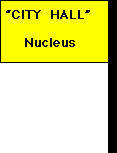
| Step 1 | Get with your group members and decide how the organelles
you researched would fit into an actual city. Example: The mitochondria could represent a power plant because it provides the cell with its needed energy. It will ultimately be the City Planners' final decision on how the cell organelles are represented. Have the REPORTER record all the information for this step and steps 2 and 3. |
| Step 2 | You will continue with step 1 until the following
organelles have been used: chloroplasts, leucoplasts, chromoplasts, cytoskeleton, cell wall, vacuole, endoplasmic reticulum, mitochondria, lysosomes, golgi apparatus, plasma membrane, nucleus, ribosomes. We are not going to use the centrioles, as the city will represent a plant cell instead of an animal cell. |
| Step 3 | Together, give your city a name. You will also name the
parts of your city that correspond to actual cell structures.
Example: The mitochondria could be named "The Mighty Power Plant." The REPORTER will also record this information. |
| Step 4 | It is your responsibility to construct the 3-D cell
city. You will not be able to begin construction until the architect and
the city planners have done their job first. It is important that the other city builder in your group be someone with whom you can work well with. You will need access to each other after school and on weekends. The construction of the city will take place at one of your homes and then brought in on the due date. You will use the architect's sketch to build the cell city. If your city does not match the sketch then YOU AND ONLY YOU will lose points. You two will decide which materials to use to represent the different structures, streets, ponds, etc... USE YOUR IMAGINATION AND BE CREATIVE. Please do not use any food product such as a green bean as they spoil too fast. Some of your specific requirements are listed below. |
 4. The
organelles should be labeled with a flag as shown to the
right.
4. The
organelles should be labeled with a flag as shown to the
right.